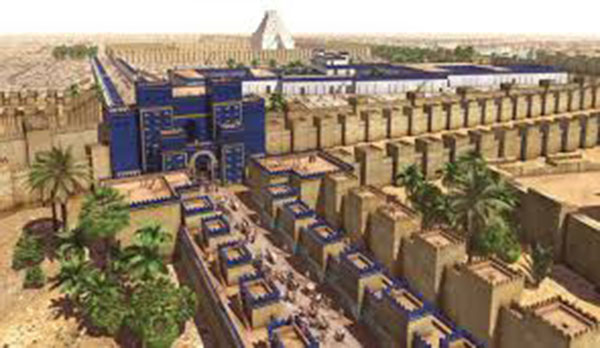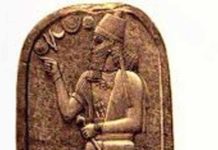The ancient city of Babylon has an interesting history of relationship to its rivers and waterways.
Mesopotamia was a civilization that built up around the area between the western Euphrates and the eastern Tigris rivers; literally translated, it means ‘land between the rivers’. The city of Babylon was situated in the southern part of Mesopotamia where a confluence of rivers flows into the Persian Gulf and marshlands exist as a result. There is little rainfall there due to the close proximity of the Western desert and the far distance from any mountain ranges.
Geography of Babylon
Nevertheless, there is no stone in the earth. Instead the low gradient of many rivers turns the soil into thick alluvial deposits of sediment. This soil is fertile and can produce much barley and emmer wheat, a main condition in the population growth that brought about the eminence of Ancient Babylon.
The stoneless earth was easy to dig into for the construction of canals and subsidiary waterways that irrigated the land. These rivers made communication between the villages and cities on the rivers possible spreading a culture of similarity.
Building Hydraulic Projects
The rivers were literally the arteries of the land. However, these tributaries could change direction at any time, shifting their course from one bed to another. The Babylonians tried to control this by building lateral canals, dams and diversions. Nevertheless, sometimes it was impossible to prevent and whole regions formerly populated could become temporarily abandoned.
Disasters
Sometimes terrible droughts would affect the land, lowering river levels to below ground and this could be dangerous for political regimes. As Leick states: ‘Again and again we see that strongly centralized states collapsed after decades of bad harvests.’ Eventually, when the knowledge of the Babylonian system of waterways was lost under the rule of the Parthians, Babylon disappeared completely.
Babylonian’s relationship to its Rivers
The importance that Babylonian society ascribed to rivers is obvious in some sources. The standard Babylon lexicon lists fields first, then cities, regions and countries, buildings, mountains and then rivers, canals and dykes. Rivers and subsidiaries headed by the Tigris and Euphrates, human-made waterways and marshes were all included.
These cuneiform texts were often copied to be used in schools. In the Creation Epic “Enuma Elish” (“In the Beginning”), the god Marduk ‘separates the primordially mingled waters into the sweet underground ocean and the salty sea’ and then creates sources of fresh water, rains and the rivers Tigris and Euphrates. City maps record the location of rivers. Twelve have survived and show how important rivers and waterways were for the Babylonians in orientating themselves to the land, where rivers could separate fields, villages, regions and cities.
History of the Rivers
Urban centers developed along the main waterways during the Early Dynastic Period (from c.2600 to 2350 B.C.). After the Isin State was established (c.2017 B.C.) following the fall of the UrIII State in about 2000 the supply of water became an increasingly pressing concern for the south. It was necessary to invest heavily in hydraulic projects like the building of new canals.
Nevertheless there was still a war between Isin and its neighbor Larsa who each cut off each other’s water supply, weakening the land. Larsa managed to gain a temporary advantage by digging a major new canal and gaining control over the Gulf ports and in 1794 King Rim-Sin of Larsa conquered Isin; proving how important access to water could be.
Hammurabi
King Hammurabi (c.1792-1750 B.C.) was soon to take over. He ruled only a small part consisting of Babylon itself plus Kish, Sippar and Borsippa. At home he concentrated on improving the economic base of his kingdom by building canals. He later managed to conquer an area similar to that of the former UrIII State, meaning he conquered all the major cult centers and trade routes from north to south and east to west. One of the most pressing concerns after this was conquest was in building up large parts of land who had suffered because of flooding and neglected waterways.
Babylon in the Seventeenth Century B.C.
By the end of the seventeenth century the ecological situation seems to have worsened especially in the south whilst in the north the lack of maintenance of important waterways became a problem. The Kassite dynasty (c.1600-1155 B.C.) led a new approach to the problem building their hub of state where the rivers Tigris and Euphrates come closest together, (about 30 km west of modern Baghdad.)
Under the Kassite rule the government invested irrigation works in particular to boost agricultural production. In the fourteenth to thirteenth centuries corvée labour was introduced as the members of the general population began to built irrigation channels and hydraulic projects, whilst also keeping them in good repair. Under Nebuchadnezzar the Euphrates River bank was strengthened with huge walls of baked brick.
Babylon’s Trade over Water
Trade was very important in Babylon, which was a prime producer of luxury goods. Ancient cities like Ur enjoyed a great volume of mercantile transactions during the third and early second millennium B.C., especially for sea-borne traffic in the Persian Gulf, but by the end of the second millennium the area was nearly deserted because of the deterioration of the soil and a shift of the waterway that connected the area with the Gulf.
Such changing fortunes were relatively common as rivers in the alluvial plain could change course and a city could sometimes lose its harbor altogether, as happened to Nippur at the end of the Old Babylonian Period; the commercial district responsible for water trade was the harbor or karum, which was traditionally located outside city walls.
The Karum
There is not much written evidence found about the karum. All we know is that there was a ‘harbor-master’ and scribes worked there also in an administrative and judicial set-up. However, we do know that the institution remained independent from the crown or city and thus provided a somewhat stabilizing social force.
The karum was a public place where locals and strangers could meet. It provided an integral part in supplying the cities with imported raw materials for various branches of Babylonian manufacture. It also exported Babylonian goods.
Reference:
- The Babylonians, Gwendolyn Leick, Routledge, London and New York, 2003







